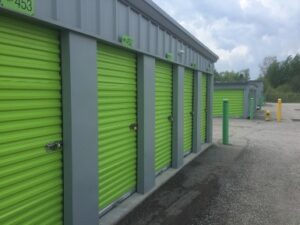
Self-Storage For Downsizing
Offsite Storage: Friend or Foe?
When you work in a storage business you become aware of who uses it, how they use it, and when they use it. In my work as a Senior Move Manager, I’ve observed many people struggling with the stress of moving and managing their belongings. I’ve seen families spending thousands of dollars to store items for years, only to end up disposing of almost all of them in one swoop. However, strategic use of self-storage is frequently used in home transitions, for many reasons.
History of Self-Storage
The self-storage industry originated in the southern United States during the mid-1950s to early 1960s. The first generation of storage facilities was located deep in industrial parks, but the concept caught on quickly and eventually evolved into the rows of concrete “garages” and the multi-story, climate-controlled buildings that are so prevalent today.
Self-Storage by the Numbers
• In 2018, the US self-storage rental revenue was $38 billion (compare this to $43 Billion for the US film industry).
• There are 54,000 storage facilities in the US (compared to 152,700 convenience stores).
• 172,000 people employed in self-storage jobs in the US.
• One in 10 people have a storage unit (that’s 5.4 square feet for every person in the US).
• The average cost of self-storage is $1.21/sqft or $121/month (That’s $1452 per year!).
Common Rental Terms for Self-Storage
• Month to month terms are the most common, with no long-term leases.
• Most facilities have a “Put on your own lock, you keep the key” policy.
• Renters must provide their own contents insurance.
• Occasionally there are security deposits and administrative fees.
• You’ll find a wide choice in access hours – Generally 7 days a week, 7 am – 11 pm. Some are 24-hour access.
• Incentives for “prepayment” and “auto pay” are common.
Who Uses Self-Storage?
Self-storage is definitely one of those things that can be a blessing and a curse. I like to describe self-storage use as “The Good, the Bad and the Ugly”:
The Good, accounting for 70-90% of rentals overall:
• Business and Commercial use (30-50%).
• Military, students, and others working away from home for extended periods.
• As a short-term solution if you are moving or otherwise between homes.
• Keeping items clean and out of the way for renovations or restoration.
• As supplemental storage for very small homes, apartments or condominiums.
The Bad: estimated at 10-19% of rentals:
• Long-term residential storage.
• Extra space when there is adequate storage at home.
• Items from an estate that may be held up in court or in limbo for personal or family reasons.
The Ugly applies to roughly 1% of rentals:
• Criminal activity
• Hoarding
• “Dumping Ground” during disputes. i.e. divorce, break ups, estate feuds, hiding items from creditors.
When to Use Self-Storage
Why would I refer my client to storage when we are getting rid of stuff? It’s actually a very common tool in home transitions when used deliberately and strategically. If the budget allows for self-storage, you may decide to rent a unit as a:
• Temporary holding space for items going to family, and friends, or to be sold or dispersed.
• A short-term place to “park” items that you can reasonably retrieve within 1- 6 months.
• A very small space for items that must be kept i.e. business records and seasonal items.
How to Identify a Reputable Self-Storage Company
In most towns, self-storage is a plentiful commodity, and you’ll have lots of choices! They are definitely not all the same so I highly recommend that you spend a little time on selecting the right one for you. You may want to consider these qualities:
• Location and proximity to your home, and convenience to access their units.
• Customer service! They should be helpful and polite on the phone and in person.
• Take a drive by the site to make sure it is clean and in good repair.
• Look for a professional and accurate website.
• Research recent feedback on their services.
• Find out their rental policies, including minimum rental terms and fee structure.
The fact is that self-storage can be both a friend and a foe. The trick is to have a plan in place and set expectations early for strategic, relatively short-term goals while you’re in transition.





